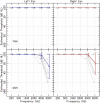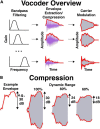Interaural asymmetry of dynamic range: Abnormal fusion, bilateral interference, and shifts in attention
- PMID: 36699517
- PMCID: PMC9869277
- DOI: 10.3389/fnins.2022.1018190
Interaural asymmetry of dynamic range: Abnormal fusion, bilateral interference, and shifts in attention
Abstract
Speech information in the better ear interferes with the poorer ear in patients with bilateral cochlear implants (BiCIs) who have large asymmetries in speech intelligibility between ears. The goal of the present study was to assess how each ear impacts, and whether one dominates, speech perception using simulated CI processing in older and younger normal-hearing (ONH and YNH) listeners. Dynamic range (DR) was manipulated symmetrically or asymmetrically across spectral bands in a vocoder. We hypothesized that if abnormal integration of speech information occurs with asymmetrical speech understanding, listeners would demonstrate an atypical preference in accuracy when reporting speech presented to the better ear and fusion of speech between the ears (i.e., an increased number of one-word responses when two words were presented). Results from three speech conditions showed that: (1) When the same word was presented to both ears, speech identification accuracy decreased if one or both ears decreased in DR, but listeners usually reported hearing one word. (2) When two words with different vowels were presented to both ears, speech identification accuracy and percentage of two-word responses decreased consistently as DR decreased in one or both ears. (3) When two rhyming words (e.g., bed and led) previously shown to phonologically fuse between ears (e.g., bled) were presented, listeners instead demonstrated interference as DR decreased. The word responded in (2) and (3) came from the right (symmetric) or better (asymmetric) ear, especially in (3) and for ONH listeners in (2). These results suggest that the ear with poorer dynamic range is downweighted by the auditory system, resulting in abnormal fusion and interference, especially for older listeners.
Keywords: aging; binaural hearing; dichotic speech; dynamic range compression; interaural asymmetry; phonological fusion; speech perception.
Copyright © 2023 Anderson, Gallun and Litovsky.
Conflict of interest statement
The authors declare that the research was conducted in the absence of any commercial or financial relationships that could be construed as a potential conflict of interest.
Figures







Similar articles
-
Interaural speech asymmetry predicts bilateral speech intelligibility but not listening effort in adults with bilateral cochlear implants.Front Neurosci. 2022 Dec 7;16:1038856. doi: 10.3389/fnins.2022.1038856. eCollection 2022. Front Neurosci. 2022. PMID: 36570844 Free PMC article.
-
The Effect of Simulated Interaural Frequency Mismatch on Speech Understanding and Spatial Release From Masking.Ear Hear. 2018 Sep/Oct;39(5):895-905. doi: 10.1097/AUD.0000000000000541. Ear Hear. 2018. PMID: 29337763 Free PMC article.
-
Effects of Spectral Resolution and Frequency Mismatch on Speech Understanding and Spatial Release From Masking in Simulated Bilateral Cochlear Implants.Ear Hear. 2020 Sep/Oct;41(5):1362-1371. doi: 10.1097/AUD.0000000000000865. Ear Hear. 2020. PMID: 32132377 Free PMC article.
-
An Alternative Explanation for Difficulties with Speech in Background Talkers: Abnormal Fusion of Vowels Across Fundamental Frequency and Ears.J Assoc Res Otolaryngol. 2021 Jul;22(4):443-461. doi: 10.1007/s10162-021-00790-7. Epub 2021 Apr 20. J Assoc Res Otolaryngol. 2021. PMID: 33877470 Free PMC article.
-
The Effect of Interaural Mismatches on Contralateral Unmasking With Single-Sided Vocoders.Ear Hear. 2017 May/Jun;38(3):374-386. doi: 10.1097/AUD.0000000000000374. Ear Hear. 2017. PMID: 28002083
Cited by
-
Best Cochlear Locations for Delivering Interaural Timing Cues in Electric Hearing.Res Sq [Preprint]. 2025 Mar 20:rs.3.rs-5640022. doi: 10.21203/rs.3.rs-5640022/v1. Res Sq. 2025. PMID: 40166036 Free PMC article. Preprint.
-
Review of Binaural Processing With Asymmetrical Hearing Outcomes in Patients With Bilateral Cochlear Implants.Trends Hear. 2024 Jan-Dec;28:23312165241229880. doi: 10.1177/23312165241229880. Trends Hear. 2024. PMID: 38545645 Free PMC article. Review.
-
Binaural fusion: Complexities in definition and measurement.J Acoust Soc Am. 2024 Oct 1;156(4):2395-2408. doi: 10.1121/10.0030476. J Acoust Soc Am. 2024. PMID: 39392352 Free PMC article. Review.
-
The Relationship Between Spatial Release From Masking and Listening Effort Among Cochlear Implant Users With Single-Sided Deafness.Ear Hear. 2025 May-Jun 01;46(3):624-639. doi: 10.1097/AUD.0000000000001611. Epub 2025 Feb 19. Ear Hear. 2025. PMID: 39966994
-
Understanding the Process of Integration in Binaural Cochlear Implant Configurations.Ear Hear. 2025 Jul-Aug 01;46(4):880-898. doi: 10.1097/AUD.0000000000001629. Epub 2025 Feb 28. Ear Hear. 2025. PMID: 40016877
References
-
- Anderson S. R. (2022). Mechanisms that underlie poorer binaural outcomes in patients with asymmetrical hearing and bilateral cochlear implants, Dissertation. Madison, WI: University of Wisconsin-Madison.
Grants and funding
LinkOut - more resources
Full Text Sources

